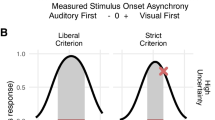Abstract
Recently, many audio-visual devices have been developed in the expanding field of virtual reality and the diversification of mass media. In these applications, the visual and auditory information is very important, because humans get environmental information mainly from their visual and auditory senses. In order to get high-reality performance, human audio-visual characteristics and their mechanism need to be investigated. In this study, the phase discrimination thresholds between visual and auditory stimuli are measured by changing the temporal frequency of the stimuli. Any periodicity can be expressed using a summation of several frequencies. By using frequency, the results can be applied to any stimulus and therefore have a wider application than the step function. The experimental results suggest that the phase discrimination thresholds are increased as the temporal frequency of the stimuli is increased. In general, it is not possible to distinguish the phase difference if the temporal frequency is higher than 3Hz. The experimental results can be applied to effective productions in virtual reality, drama, and the mass media, and can contribute to elucidating human audio-visual, mechanisms.
Similar content being viewed by others
References
Kashino K, Tanaka H (1994) A computational model of auditory segmentation of two frequency components—evaluation and integration of multiple cues (in Japanese). IEICE Part A, vol. J77-A, No 5:731–740.
Engel S, Zhang X, Wandell B (1997) Colour tuning in human visual cortex measured with functional magnetic resonance imaging. Nature 388:68–71.
Ohkura M, Yanagida Y, Tachi S (1995) Sound distance localization using environment (in Japanese). SICE 31(9):1318–1323
Iwamiya S-I (1992) The effect of the matching of sound and video on the interaction between auditory and visual processing in communication via audio-visual media (in Japanese) JASJ 48:649–657
Iwamiya S-I (1992) The interaction between auditory and visual processing when listening to music via audio-visual media (in Japanese). JASJ 48:146–153
Wu J-L, Mizuhara H, Nishikawa Y (1998) Measurement of human visual and auditory characteristics for a virtual driving system. In: Sugisaka M (ed) Proceedings of the International Symposium on Artificial Life and Robotics (AROB 3), Beppu, Oita, Japan, January 19–21, 1998.
Author information
Authors and Affiliations
Corresponding author
About this article
Cite this article
Wu, JL., Nobuki, O. Human visual and auditory characteristics in the temporal frequency domain. Artif Life Robotics 4, 62–67 (2000). https://doi.org/10.1007/BF02480858
Received:
Accepted:
Issue Date:
DOI: https://doi.org/10.1007/BF02480858




